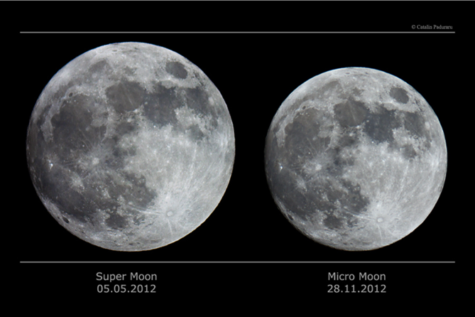Three Supermoons Coming this Summer
May 16, 2018
From causing lunacy to creating natural disasters, there are a lot of misconceptions about supermoons.
This summer, there will be three supermoons, coming on June 13th, 2018, as well as July 13th, 2018 and August 11th, 2018. These three supermoons will fall at the new moon phase, so unfortunately they will be invisible to the human eye almost everywhere. Although, if you are in Southern Australia or Antarctica, the new supermoon will be visible during the July 13 partial solar eclipse.
The moon, “Earth’s only natural satellite,” was created when “a giant impact knocked off the raw ingredients for the moon off the primitive molten Earth and into orbit,” according to Space. Every 27.3 days, the moon completes an orbit around Earth as well as one full rotation.
Throughout the 27.3 days, the view of the moon from Earth changes quite a bit. A cause of this is that the moon does not create its’ own light. The light we see from the moon is a reflection of 3-12% of the light from the sun that hits the moon, according to Live Science.
According to NASA, “if we could magically look down on our solar system, we would see that the half of the Moon facing the Sun is always lit. But the lit side does not always face the Earth.” Because of this, the moon needs to be angled so the light hitting the moon is visible from the Earth. As the moon orbits the Earth, the amount of light we can see changes which causes the eight phases.
The first phase is called new moon. In this phase, the moon is between the sun and the Earth, so it is not visible to people on Earth. Every so often, the moon, Earth, and sun will be in a line where the moon is directly between the sun and the Earth. When this happens, the moon blocks the sun, causing a solar eclipse.
This is the phase that the moon will be in for the three upcoming supermoons. A supermoon is “a new or full moon closely coinciding with perigee, the moon’s closest point to Earth in its monthly orbit,” according to EarthSky.
In this position, the moon will appear larger because of its proximity to earth. To the amature observer, the change in size may be unrecognizable, but the moon will appear larger when close to the horizon, according to CNN.
Although the moon is the same size on the horizon as it is in the sky, the moon will appear largest at the horizon. Once thought to be caused by the “Earth’s atmosphere enlarging the image of the horizon moon, just as water can make immersed objects seem magnified to our eyes,” the moon illusion has baffled scientists for centuries, according to National Geographic.
The most popular theory is that “our brains [are] trying to compensate for the moon’s perceived position in front of a flat, distant sky by distorting the size of the moon,” said National Geographic
Even though the moon is perceived to be larger, if you take pictures of the moon on the horizon and compare it to pictures of the moon higher in the sky, it will be the same size. While the moon will never be as large as it appears to be in our heads, the supermoon is the closest it will get.
Although the moon’s actual size is smaller than its perceived size, the effect the moon has on earth is real. The change from “minimum lunar pull to maximum pull is roughly 23 percent,” according to EarthSky. This increased pull will make tides slightly higher.
While their size and effect can be misleading, the upcoming supermoons are something to look forward to.






